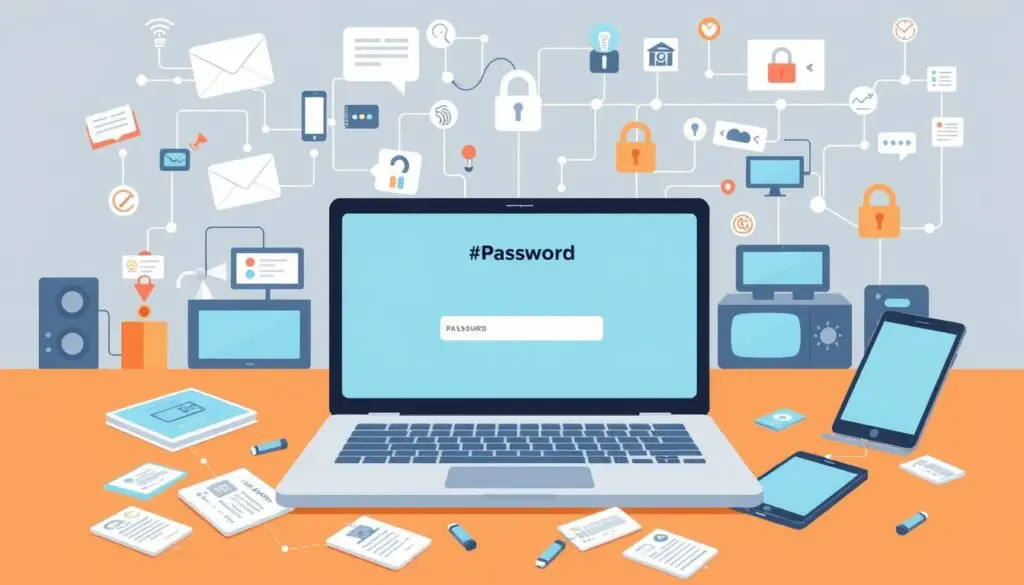Did you know that 81% of data breaches are linked to weak or stolen passwords? Managing our digital lives means dealing with many accounts and passwords. Forgotten passwords can be a big problem, leading to frustration and security risks. It’s important to use good password management to keep our data safe.
In this guide, we’ll look at fast ways to recover forgotten passwords. We’ll also share important tips to prevent password issues. Plus, we’ll cover the best practices for better online security.
The Importance of Password Management
Effective password management is key to keeping personal info safe and secure online. Many people don’t realize how important it is. This can lead to serious threats. Passwords that are easily guessed or reused across sites are big risks.
Understanding Password Vulnerabilities
Knowing about password vulnerabilities helps spot the dangers of bad password habits. Many choose passwords that are too simple, like birthdays or names. This makes it easy for hackers to get in. To stay safe, use unique passwords for each site and change them often.
Common Mistakes in Password Management
Some common mistakes include:
- Reusing passwords across multiple accounts.
- Choosing easily guessable passwords.
- Neglecting to update passwords periodically.
- Ignoring the use of two-factor authentication.
These mistakes can weaken your online security. It’s important to know about them and take steps to improve your protection. By fixing these issues, you can make your digital life much safer.
Best Practices for Creating Strong Passwords
Creating strong passwords is key to protecting our online world. Using strong password traits keeps our accounts safe and reduces the chance of unauthorized access. A good password mixes letters, numbers, and symbols, and is long and hard to guess.
Characteristics of a Strong Password
Strong passwords have to meet certain criteria to boost security. Key traits include:
- At least 12-16 characters in length
- A mix of upper and lower case letters
- Numbers included
- Use of symbols like @, #, $, %, etc.
- Avoid dictionary words or easy guesses
How to Remember Complex Passwords
It’s important to remember complex passwords too. Here are some tips to help:
- Create a passphrase from a memorable sentence, using abbreviations or first letters.
- Use mnemonic devices to link your password to a vivid image or story.
- Make it themed, personal, but hard for others to guess.
Following these tips helps us create a strong password practice. This protects our digital world well.
Password Managers
Password managers are key for managing many accounts and passwords. They keep your credentials safe and help create strong passwords. Knowing their benefits and how to pick the best one is important.
Advantages of Using a Password Manager
Password managers offer many password manager benefits. They are great for both businesses and individuals. Here are some main advantages:
- Secure storage of all passwords in one place
- Automatic filling of login credentials, saving time
- Generation of complex passwords that are hard to guess
- Access to passwords across multiple devices
How Password Managers Enhance Security
Using a password manager greatly improves our security. It helps us:
- Reduce the risk of password reuse across different sites
- Safeguard sensitive information with encryption
- Regularly update passwords with minimal effort
This way, the best password manager helps protect us from data breaches.
Choosing the Right Password Manager
With many options, we need to compare password managers carefully. Key things to look at include:
- Security features, like two-factor authentication
- User reviews regarding reliability and support
- Compatibility with existing devices and software
Common Features of Password Manager Apps
Password manager apps have key features that boost our online safety. They make managing our login details easier. This helps us protect our digital world better. Knowing what these features are helps us pick the right tool for us.
Centralized Password Storage
Centralized password storage is a top feature of password managers. It lets us keep all our passwords in one safe spot. This way, we can manage many accounts easily without remembering each password.
This makes life simpler and cuts down the chance of forgetting passwords.
Automatic Password Generation
Automatic password generation is another great feature. It lets us create strong, random passwords easily. This takes the stress off of making up our own unique passwords.
Using this feature ensures our passwords are strong. It also lowers the risk of using weak passwords.
| Feature | Description | Benefit |
|---|---|---|
| Centralized Password Storage | Stores all passwords in a secure vault | Easier management and access to all accounts |
| Automatic Password Generation | Creates strong, random passwords automatically | Reduces risk of weak passwords and enhances security |
| Password Sharing | Allows safe sharing of passwords with trusted contacts | Facilitates collaboration without compromising security |
| Two-Factor Authentication | Adds an extra layer of security | Minimizes the chance of unauthorized access |
Limitations and Risks of Password Managers
Password managers are great for keeping your online accounts safe. But, they’re not perfect and come with some risks. If a password manager gets hacked, all your account details could be at risk. It’s important to know these limitations and how to make your security stronger.
Potential Risks of Using a Password Manager
There are a few risks to think about when using a password manager:
- Single Point of Failure: If one part gets hacked, all your accounts could be in danger.
- Phishing Attacks: You might accidentally give out your login info to fake sites.
- Compatibility Issues: Some sites might not work well with certain password managers, making it hard to log in.
Security Measures for Password Managers
To make your password manager safer, consider these steps:
- Choose a well-known password manager with good security features.
- Turn on two-factor authentication to add an extra layer of protection.
- Keep all your passwords and settings up to date to stay safe from threats.

Tips for Secure Password Storage
Keeping your online accounts safe is key. Using two-factor authentication is a great way to do this. It adds an extra layer of protection against hackers. Also, updating your passwords often helps keep your info safe from breaches.
Using Two-Factor Authentication
Two-factor authentication is a strong security tool. It combines your password with something you have, like a phone or token. This makes it much harder for hackers to get into your account. You can choose from text codes, apps, or even your face to verify your identity.
Regularly Updating Passwords
Changing your passwords regularly is important. It makes stolen passwords useless to hackers. Try to update your passwords every few months. Use a password manager to help you create and keep track of strong, new passwords.
The Role of Passphrases in Password Security
In today’s digital world, strong password security is key. Passphrases offer a new way to protect our online identities. They mix four or five random words into phrases that are easy to remember but hard to guess.
Creating Memorable Passphrases
Making passphrases that stick in your mind can prevent lost access to accounts. By linking words in a way that’s logical or funny, we create phrases that are memorable. For instance, “BlueSkyPaddleDance” is a better choice than “Apple123” because it’s longer and harder to guess.
Advantages of Passphrases over Traditional Passwords
Passphrases have clear benefits over passwords. They are longer and made of meaningful words, unlike passwords that can be short and hard to remember. This makes passphrases more secure against hackers. Plus, they help us avoid weak passwords that are easy to guess.
For more on how to manage passwords safely, check out this guide: best practices for passphrases and passwords.
| Criteria | Passphrases | Passwords |
|---|---|---|
| Length | At least 15 characters | Minimum of 12 characters |
| Complexity | Random words, easy to remember | Mixed characters, harder to recall |
| Security Level | Higher due to length and structure | Vulnerable to simple guessing |
| Ease of Use | More memorable, reduces reset attempts | Often forgotten, leading to recovery issues |
Implementing Online Security Measures
In today’s digital world, keeping our accounts safe is key. A good plan includes strong passwords and more. Multi-factor authentication is a top choice for extra security.
Utilizing Multi-Factor Authentication
Multi-factor authentication makes accounts much safer. It asks for more than just a password. You might need a code sent to your phone or to use your face or fingerprint.
This way, even if someone guesses your password, they can’t get in. It’s a strong defence against hackers.
Monitoring Account Activity for Suspicious Behaviour
It’s important to watch your account activity closely. This helps spot any odd behaviour fast. Look out for strange logins or transactions.
Quick action can stop hackers in their tracks. It keeps your personal info safe and sound.

Steps to Take if Your Account is Compromised
If our account gets hacked, we must act fast. First, we should report fraud to the right people. This keeps our info safe and stops others from getting hacked too. We need to tell groups like the Canadian Anti-Fraud Centre about it.
Reporting Fraud to Authorities
After we know our account is hacked, we must report it. This alerts the right groups and helps fight cybercrime. Here’s what to do:
- Contact the Canadian Anti-Fraud Centre to file a report.
- Notify your financial institutions to secure your accounts.
- Inform local law enforcement if necessary.
- Document important details about the breach for future reference.
Restoring Your Account Access Safely
After reporting the fraud, we can work on getting back into our accounts safely. Here are some steps to follow:
- Change passwords for all compromised accounts immediately.
- Enable two-factor authentication if available.
- Verify recovery options such as email and phone numbers.
- Monitor account activity for any strange transactions.
Maintaining Vigilance Against Cyber Threats
It’s important for everyone to stay alert against cyber threats. Being proactive in cyber threat awareness helps us spot and stop risks. Knowing how to spot phishing attempts is key to keeping our info safe. By staying informed and doubting unsolicited messages, we protect our sensitive data.
Awareness of Phishing Attempts
Phishing scams can look real at first. Knowing the signs helps us act fast. Look out for:
- Unusual sender email addresses or domains
- Generic greetings instead of personalized messages
- Urgent requests for sensitive information
- Suspicious links that lead to unfamiliar websites
By staying alert and learning more, we build strong defences against cyber threats.
Educating Yourself and Others about Cybersecurity
Learning about cybersecurity is essential. Talking about safe practices helps everyone. Share knowledge on:
- Regularly training employees on recognizing phishing attempts
- Establishing clear protocols for reporting suspicious communications
- Encouraging strong password management habits
By promoting cybersecurity education, we protect ourselves and help keep the internet safe for all.
Conclusion
Managing passwords well is key to keeping our digital world safe. A good password security summary shows how important it is to protect our online data. By making strong passwords and using good password managers, we fight off cyber threats.
We urge business owners and leaders to start using these methods. It’s important to create a culture where keeping data safe is a priority. By doing so, we protect our own information and help make the internet safer for all.
